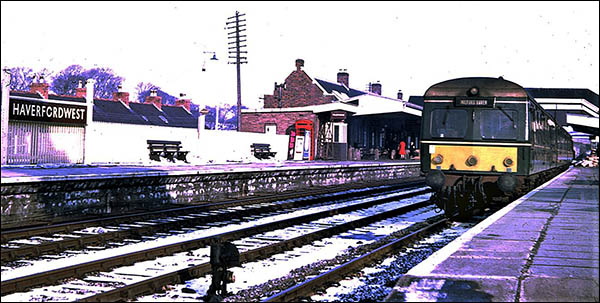Haverfordwest railway station
Haverfordwest was cleared of “all nuisances” and decorated with bunting for the ceremonial opening of its station in December 1853. A banquet was laid on for c.1,000 guests. A ball followed an evening fireworks display.
Isambard Kingdom Brunel had recommended the South Wales Railway’s route from Carmarthen to Neyland, for Irish Sea ship connections. Initially the line terminated here. The track was to Brunel’s broad gauge, converted later to Britain’s standard gauge.
When Haverfordwest’s passenger trains began in January 1854, there were only three departures per day, one each to London, Cheltenham and Swansea. The London “express” took from 9.15am to 6pm! Sidings east of the station catered for local goods, which soon included ammunition supplies for the Milford Haven waterway’s defences.
 The London to Carmarthen mail train was extended later in 1854 to Haverfordwest, where it arrived at 8.20am. The White Lion Hotel, Tenby, provided a connecting horse-drawn coach to Tenby and Pembroke.
The London to Carmarthen mail train was extended later in 1854 to Haverfordwest, where it arrived at 8.20am. The White Lion Hotel, Tenby, provided a connecting horse-drawn coach to Tenby and Pembroke.
The second stationmaster, a Mr Batchelor, was dismissed for sending railway porters to tend his own garden in Johnston. Trains made special stops at Johnston for the gardeners!
The railway’s extension to Neyland, opened in 1856, curved southwards after Haverfordwest station and crossed the Cleddau well below the town and quay. The Admiralty had ordered the SWR to dredge under the proposed bridge so that vessels could pass, but shipowners protested and the SWR had to provide a lifting span.
Farmer Phoebe Lewis died in 1879 after being struck by the “Irish goods train” while crossing the railway near Haverfordwest station, taking butter to market.
In the 1880s the town council lobbied for a subway to end the “danger” of the station’s level crossing for passengers. The Great Western Railway (which had taken over the SWR) built a covered footbridge.
In 1917 GWR porter Frederick Morris Williams was knocked down by a train at the station. The jurors at his inquest gave their fees to his widow, who had six children to bring up.
When John Davies took the photo in 1963, there was still a central track through the station. This track was latterly used by oil trains from Milford Haven refineries.
With thanks to John Davies
Postcode: SA61 2LH View Location Map
Sources include the National Library of Wales and ‘The Railways of Pembrokeshire’ by John Morris, published by HG Walters 1981.



